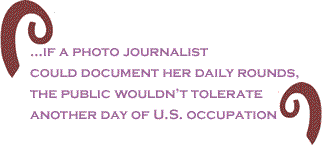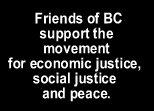
|
||||||||||||||||||||||
 |
||||||||||||||||||||||
 |
||||||||||||||||||||||
 |
||||||||||||||||||||||
 |
||||||||||||||||||||||
 |
| The current issue is always free to everyone |
|
|
 |
| In his magisterial and award winning new book,
The
Slave Ship: A Human History In particular, the images of life aboard the
slave ship Brooks were "among the most effective propaganda
any social movement has ever created." Reading Rediker's book prompted me to think
about powerful images that affected my own political consciousness,
beginning with the civil rights Movement and later, Photos that I vividly recall making an impression
on me include 15-year-old Elizabeth Eckford being viciously
taunted by a young white girl as she attempted to enter Ron Haeberle’s photo of terrified women and
children in But that was another era. Today the limitations
placed on exposure to powerful images that might stir our
deepest emotions would impress a modern day Dr. Goebbels.
We know that photographers are banned from the Iraqi battle
zone while too many others are pressured into self-censorship.
And therein resides both an intractable indictment and a vexing question. Would images of an Iraqi Emmett Till or Kim Phuc be published today? Photo journalist Mary Anne Golon asserts that images have power because they “serve as evidence for accusations of wrongdoing.” Given that we now have irrefutable proof from neuroscience that human brains are hard-wired for empathy, that we are morally predisposed toward identifying with the “other,” we might speculate on the potential impact such images would evoke within American society. I would argue that the tremendous amount of
deception and fraud expended by BlackCommentator.com Guest Commentator, Gary Olson, Ph.D., chairs the Political Science department at Moravian College in Bethlehem, PA. Click here to contact Dr. Olson. Click here to contact Dr. Olson.
|
Your comments are always welcome. e-Mail
re-print notice
If you send us an e-Mail message we may publish all or part of it, unless you tell us it is not for publication. You may also request that we withhold your name. Thank you very much for your readership. |
|
| April 24, 2008 Issue 274 |
|
| Executive Editor: Bill Fletcher, Jr. |
| Publisher: Peter Gamble |
| Est. April 5, 2002 |
| Printer Friendly Version in resizeable plain text format format |
 |
 |
 |
| |
| |























 The
Pentagon forbids media coverage of the remains of soldiers
departing Ramstein Air Base in
The
Pentagon forbids media coverage of the remains of soldiers
departing Ramstein Air Base in 





